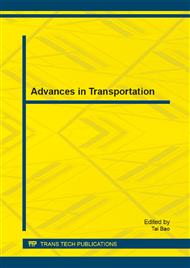p.68
p.72
p.77
p.82
p.89
p.97
p.102
p.106
p.111
The Quantitative Assessment of Objective Security about Two-Lane Highway’s Intersection in Mountainous Area
Abstract:
In order to quantitatively evaluate the objective security of intersection in mountainous area, a danger index model was built after analyzing the factors of two-lane highway‘s intersection in mountainous area. The model was based on the highway conditions of the intersection, the traffic conditions around the intersection and the environment of intersections. According to the weight of every index and the danger index, the model divided the objective security into four ranks. The relevant data of several typical intersections in Shanxi province are evaluated. The conclusion shows the model can evaluate the objective security about the two-lane highway’s intersection in mountainous area quickly and effectively.
Info:
Periodical:
Pages:
89-96
Citation:
Online since:
January 2014
Price:
Сopyright:
© 2014 Trans Tech Publications Ltd. All Rights Reserved
Share:
Citation:


